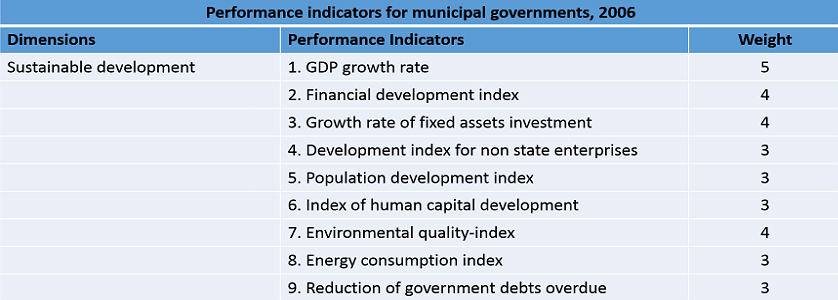Global E-Governance Index – Study Case Singapore

Globalization and the rapid progress of info-communications technologies are bringing about fundamental changes in all aspects of our society.
Get the opportunity to grow your influence by giving your products or services prime exposure with Performance Magazine.
If you are interested in advertising with Performance Magazine, leave your address below.

Globalization and the rapid progress of info-communications technologies are bringing about fundamental changes in all aspects of our society.

The role of the government has been evolving over the last several years. Gone are the days when agencies simply served as administrative bodies that did little more than set and enforce regulations, collect, process and store information.

The first World Happiness Report was published in April 2012, in conjunction with the U.N. High Level Meeting on happiness and well-being.

If we closely analyze the evolution of the Chinese economy of the last two decades, the results are noteworthy. The country has been able to transform its economic pace, becoming one of the strongest, if not the strongest, player in terms of international trading, product manufacturing capabilities, gross domestic product (GDP), along with a population that in 2016 almost reached 1.4 billion people.
Besides these relevant indicators, since the early 1980s China had implemented a methodology that had, as an objective to improve government efficiency, ensured policy compliance at both the local and the Institutional level. This scheme was a Performance Management System, which along the years, has grown in terms of content and technicality.
China’s commitment to improve its processing of activities and to deal with human resource management, has evolved and changed through several administrative reforms that have occurred in the last thirty years, and that have been mainly focused on structural changes. These reforms were implemented from the Central Government in a top-down manner.
The reforms were beneficial because they strengthened China’s audit capacity, which was focused on monitoring how local governments achieve their own targets. Local authorities weren’t able to manage themselves and assess important functions. For this reason, several managing methods for local county governments had emerged. They represented the “vertical” and “semi-vertical” system that differed from the functional area in terms of responsibility, authority and central – provincial geographical position.
Following the several rounds of government restructuring from the early 1980s, a new civil system, which promoted civil resource management based on merit and performance, was presented. These performance-based reward systems incentivized China’s pursue of a performance management regime even further, distancing themselves from the previous system, a system that was created and ran according to different criteria – as position-based pay.
However, even though the regulations seemed rational and significant, there were several policies and requirements that had to be followed. For instance, status/qualifications had a noticeable influence on performance evaluation, along with a maximum percentage of civil servants that could be ranked as “outstanding”. Finally, the limited possibility of promotion within the working environment, had a negative impact on the performance-based rewards system.

Modern Performance Management arrived in China under the official name of “Objective Responsibility System” (ORS) at the local government level, and it was concerned with setting goals for the secondary provincial government. When implemented, the voluntary nature of the adoption and the lack of a unified guideline, resulted in different variations of ORS according to the regions of the country.
Furthermore, following the principles of “Management by Objective” (MBO), the ORS also involved:
One important feature of the ORS is that it was carried out top-down in a centralized manner, setting-up targets and cascading to the lower layers of governments (ex. Township-level), forming a network of targets in the form of economic growth rate and related performance indicators.
Moreover, the ORS of the 1990s has always had a single-facet focused on economic growth, giving noticeable weight to GDP growth in terms of target setting and performance evaluation. Except for a few monitored non-economic indexes, all the main indicators led, directly or indirectly, to an improvement of the GDP growth.




After entering the 21st century, the “Objective Responsibility System” went through some important changes. Soon after the GDP cult, during the huge environmental and great social losses of the last years of the 1990s, top leadership decided to broaden the focus of the ORS. They put more weight on social, “human-centered” principles, public service functions, sustainable development and administration by law.
An example showing these transitions was launched by the Qingdao City of Shandong Province in 2002. The example reveals that the ORS content covered economic and social development, as well as administrations according to law, transparency and service attitude.
Since the mid-1990s, China’s performance management has developed quickly, in comparison to its economic development. In the beginning, the ORS was primarily designed for internal hierarchical control and it was focused only on economic growth, neglecting all the social, environmental and administrative processing indicators. Soon after the end of the 1990s, China’s public sector performance placed more emphasis on social functions and public services, experiencing an increased citizen involvement in performance measurement at the government level, through citizen public assessment surveys. This transition towards more non-economic indexes came from both the center government and the local province governments.
Despite the progress achieved until now, that of a much greater public participation in the measurement of government performance, the system remains slightly limited and in need of improvement, especially when the demands of human development must be met.
Image sources:

Strategic planning – is it just a fancy way for top executives to spend time and energy working on formal documents that have no real impact in the organization, or is it a remedy that can solve many issues within the organization?